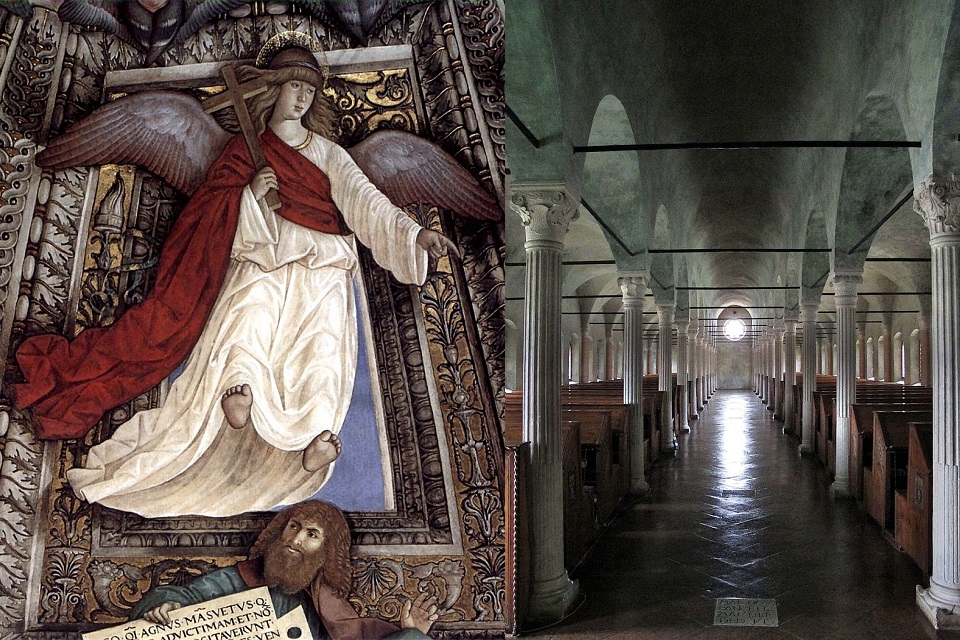

In Romagna the arrival of the Renaissance produced some important artistic declinations in the Italian panorama. The most important center was Rimini, which had a brief but intense artistic season with the lordship of Sigismondo Pandolfo Malatesta, derived from the example of Urbino by Federico da Montefeltro, but with its own characteristics.
From the example of Rimini derive the blooms in nearby cities such as Cesena and Forlì. In the latter the numerous ideas of northern Italy flourish in an autonomous school, the only one in the region.
Rimini
The Renaissance season of Rimini was in many ways similar to that of Urbino by Federico da Montefeltro, depending exclusively on the initiatives of its lord, Sigismondo Pandolfo Malatesta (from 1432 to 1468), who for his ambitious and important projects called artists from other regions of great importance, some of which (Leon Battista Alberti, Piero della Francesca), they were also active in Urbino. The self-congratulatory characters of the Malatesta were, however, more accentuated and, both for the brevity and for the different intellectual stature of its protagonist, the Renaissance in Rimini failed to originate a culture endowed with its own, precise, physiognomy, so much so that at death of Sigismondo the factories remained interrupted and there were no further artistic developments.
Sigismondo Pandolfo Malatesta’s works on Rimini were not part of a unitary urban project, but limited themselves to dominating the town, unequivocally signaling the presence of power: the fortified residence of Castel Sismondo and the Tempio Malatestiano, a dynastic mausoleum. The glorification of the client was the culmination of the fresco by Piero della Francesca Sigismondo Pandolfo Malatesta in prayer before Saint Sigismondo (dated 1451), where the religious frame is intertwined with political and dynastic aspects, as in the features of Saint Sigismund which conceal those of emperor Sigismund of Luxembourg, who in 1433 he invested Malatesta as a knight and legitimized his dynastic succession, ratifying his seizure of power.
Cesena
The seigniory of the Malatesta brothers in Cesena brought a lively renaissance season, until 1465, the death of Malatesta Novello, and then continued briefly during the reign of Cesare Borgia. Of that season the Malatestiana Library remains above all, an intact and extraordinary work similar to the Albertian influence, which can be guessed from the harmony of the proportions of the hall. At the same time, the quality of light can evoke the masterpieces of Piero della Francesca, whose presence in the city has been repeatedly hypothesized. However, the author is Matteo Nuti da Fano, mentioned in the inscription of 1452, at whose side worked Cristoforo from San Giovanni in Persiceto, who signs the entrance door, and the sculptor Agostino di Duccio, also active in Rimini. Also worthy of mention is the visit of Leonardo da Vinci, in 1502 at the behest of Cesare Borgia, who makes reliefs to the Rocca and provides the project for the port of Cesenatico.
Forlì
Reduced by a lively artistic scene in the fourteenth century, Forlì was immediately at the forefront of the new style with Ansuino da Forlì who worked alongside Mantegna in the Ovetari Chapel of Padua. He was perhaps a master of Melozzo who, inspired also by Piero della Francesca, created scenes with light colors, soaked in light, and by the lucid perspective construction, which did not fear the most daring glimpses made up to then in Italy. up that not even the Florentines mastered.
Acclaimed in Rome and Loreto, he remains little in his city. On the contrary, the work of Marco Palmezzano, the other great architect from Forlì, is more widespread on the spot, who invented his own style drawing on a wide range of available influences.
Faenza
Faenza was probably the most important European center for the production of majolica, where the most advanced techniques were experimented and then acquired also the other production centers scattered around the peninsula.
In the second half of the fifteenth century the production of graffita and painted majolica was established, both on symbolic themes that are sensitive to neo-Platonic instances, and with the amatory genre or the representation of virile and feminine faces with delicate formal purity. In the 16th century, the workshops in Faenza reached their own linguistic independence, together with a high technical quality, with the affirmation of the characteristic ornaments of the full Renaissance. The grotesque paintings on blue surfaces (type of cap) and the representation of themes taken from mythology and from the Old and New Testament, the so – called historiated style, spread.
Little more than half of the sixteenth century in the production of Faenza there was a change of stylistic and formal horizon, based on the rediscovery and exaltation of white, with the so-called ” whites of Faenza ” with a dense milky color.
Source from Wikipedia